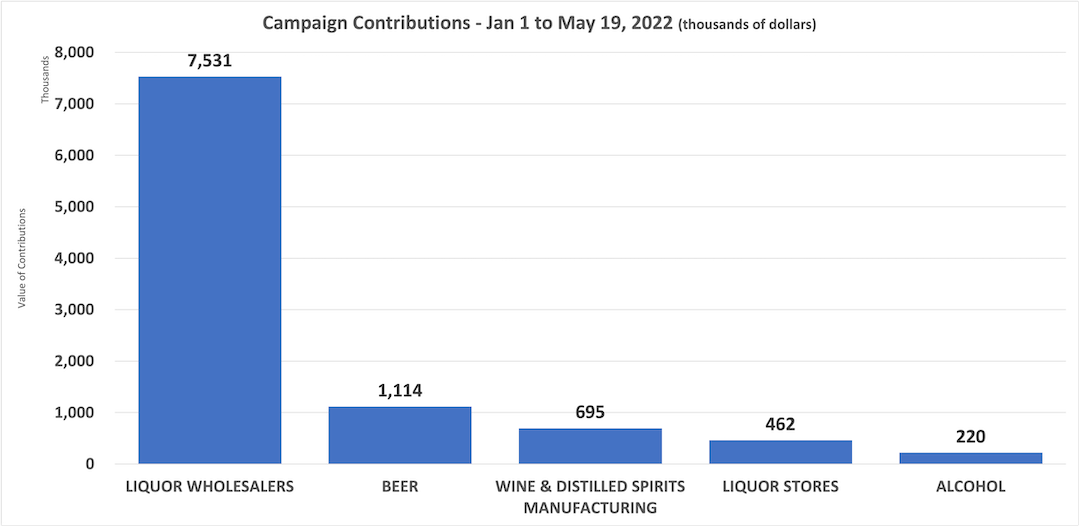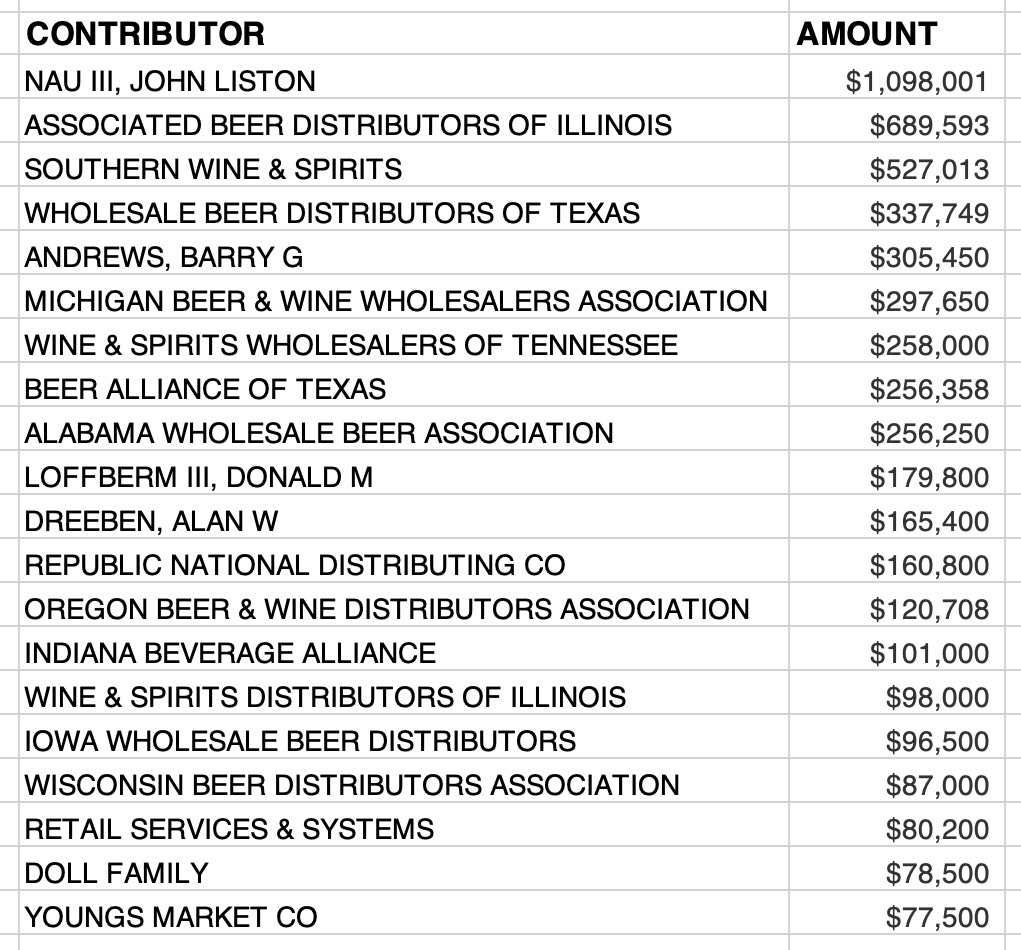This Is What Protection from Competition Costs
The up-to-date tally of wholesaler campaign contributions for 2022
We are halfway through May with roughly 6 months to go before the general elections in November. Let’s see how the alcohol industry is doing with their campaign contributions
This breakdown shows how many thousands of dollars wholesalers, beer producers, wine and spirits producers, alcohol retailers and the “alcohol sector” has given JUST TO STATE-BASED CAMPAIGNS, not to candidates for federal office.
Yes, that’s actually $7.5 million that America’s wholesalers have contributed to campaigns this year…and we still have six months to go. And, yes, that $7.5 million is three times the amount the entire rest of the alcohol industry has given in campaign contributions.
Did you know that one of the primary goals of those designing alcohol regulations in the wake repeal of Prohibition in 1933 was to deter the alcohol industry from exerting influence over lawmakers it did prior to Prohibition? It seems like the institution of the three-tier system and tied house laws has done a great job of accomplishing this…except for one segment of the industry.
Anyway…
Let’s take a look at who has been the recipient of this wholesaler largess.
TOP 20 RECIPIENTS OF WHOLESALER CAMPAIGN CONTRIBUTIONS TO STATE CANDIDATES FROM JANUARY 1 TO MAY 19, 2020
One suspects that Governor Greg Abbot of Texas knows the Texas Wholesaler lobby quite intimately.
But who are the wholesaler folks most concerned about state politics?
TOP 20 WHOLESALER CONTRIBUTORS TO STATE POLITICAL CAMPAIGNS FROM JANUARY 1 TO MAY 19, 2020
If you are wondering, John Nau is president of Texas’ Silver Eagle Distributors, the largest Budweiser wholesaler in Texas.
What’s important to understand is that by the time the November election rolls around, American alcohol wholesalers will have contributed somewhere between $18 and $20 million dollars to state-based political campaigns. The state is where the bulk of their contributions are sent since it is at the state level where all the political action occurs concerning alcohol.
However, by the end of the year wholesalers will also have contributed between $5 and $7 million to federal campaigns. In all, wholesalers will contribute between $23 and $26 million to political campaigns in the U.S. in 2022.
If you want to see what that looks like in the ten years from 2012 to 2021, American alcohol wholesalers contributed $139 million to state and federal political campaigns. And this won’t include the millions they will spend on lobbyists and lobbying. You can tack on many more millions.
What possible reason could alcohol wholesalers have for so thoroughly outspending the rest of the alcohol industry on campaign contributions? Protection. Protection of laws that require producers to sell to wholesalers. Protection. Protection of “franchise laws” that play no other role in the marketplace other than to make it nearly impossible for producers to take their business to another wholesaler. Protection. Protection for the obscenely high margins wholesalers can take when state laws require alcohol sales to go through them. Protection. Protection in the form of state laws that bar consumers in states from purchasing wine, beer, and spirits from out-of-state retailers, distillers, and brewers and are forced instead to purchase the crappy selection of products wholesalers deliver to retailers and bars.
With the exception of the lawmakers who take wholesaler money, no one in the industry and no consumers actually buys the contrived arguments wholesalers make concerning the necessity of the three-tier system. That system doesn’t protect consumers, it doesn’t protect the public from tied houses and it doesn’t protect minors from obtaining alcohol.
It protects wholesalers from having to compete in an open marketplace and, in particular, protects the two or three multi-billion, multi-state wholesalers when they lie to politicians about their intentions.
It’s not difficult to understand why they spend millions. The protection racket is expensive.








Unfortunately, it sounds like the 1000 or so nationwide retailers actively shipping would have to chip in more than 100,000 each just to get on the playing field. The 1000 number came from one of your NAWR presentations. So I assume that is what we have to work with.